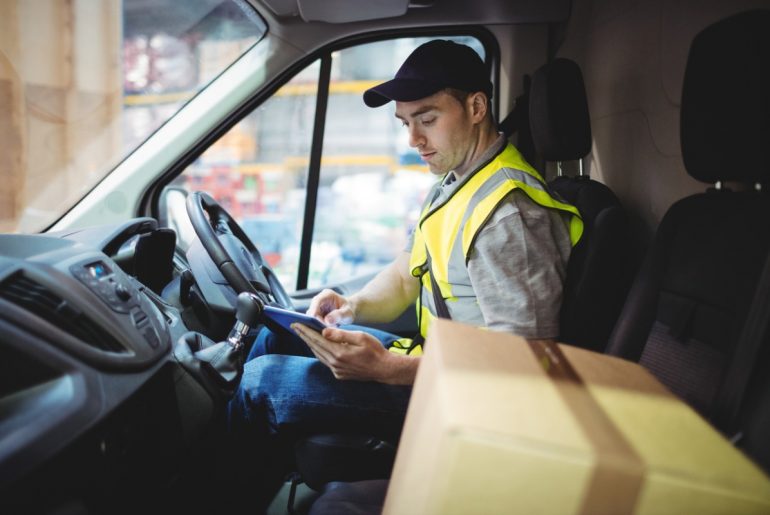The importance of route optimization is always evident during your everyday deliveries, but recent spikes in orders and shifts in customer expectations have brought the need for route optimization into an even sharper focus. As you strive to provide fast turnaround and excellent customer service, here are a number of ways to take full advantage of WorkWave Route Manager.
1) Enable Contactless Delivery With Customer Notifications
Social distancing has had an immediate impact on the way customers expect their items to arrive. The need to avoid direct contact with others has led to a rise in requests that items be left by the front door or on the porch. Even as areas look to “return to normal,” the ongoing expectation of contactless deliveries adds to the need for customers to be informed so that they can retrieve their deliveries promptly after they’re left.
At the beginning of the day, use Route Manager to set up email or mobile alerts for each customer with the estimated time of arrival for their delivery. The email or mobile notifications you schedule to send to your customers will also include the driver’s ETA and live on-map location so that they can stay up-to-date as the delivery draws closer. Along the way, be sure to send alerts whenever the status of their order changes. This will provide convenience for your customers and your drivers, and will also let your drivers move on more quickly to the next stop.
2) Verify Delivery Accuracy With Route Manager Proof of Delivery and Barcode Scanning
Contactless delivery options can have the unfortunate side effect of making customers feel detached, even when it’s an option that they prefer. It’s important to ensure that you’re communicating with your customers whenever possible, and it’s also important that the right package is delivered to the right place. Using barcode scanning, you can quickly check the barcode against your original order to ensure it’s where it needs to be and then take a picture of where the package was left; both operations are carried out quickly using your driver’s mobile device. This proof of delivery is stored in Route Manager automatically, allowing you to send the photo to your customers as verification. This not only allows for delivery accuracy and transparency but also adds a personal touch that your customers will appreciate.
3) Ease Your Normal Routing Restrictions to Open Up Availability
Increased demand for deliveries requires adaptation on your business’s end of things to ensure that customers remain satisfied. With this increase in demand, you may realize that you’re not staffed to absorb the extra work right now.
Under normal circumstances, you may assign particular drivers to stay in a certain area or to serve a subset of orders. Easing your normal restrictions during busier times is a fast and flexible way to adapt to increased orders. Routing constraints like Regions and Tags are flexible enough to allow maximum availability for your drivers to take orders, even if the order is outside of their normal area. As companies like Amazon and Peapod change their procedures to adapt to the current market, you must be flexible enough to do the same and remain competitive.
4) Simulate Routes With Tighter Time Windows and Shorter Service
Handling more orders is the key to keeping your customers satisfied when demand increases. To get an idea of how many orders you can handle comfortably, convert a typical route to a Route Manager Simulation and see what happens when you reduce the amount of time you spend with customers or reduce your arrival window—these criteria reflect the scenario that comes with contactless drop-offs.
Try tightening your Time Windows for delivery, pickup, or service, then explore the resulting simulation. If you’re not happy with the results, don’t use them; this is where your firsthand experience and insights are key. If you believe you can maintain your service standards with these changes, though, send that route from Simulations to Operations and dispatch it to help streamline your efficiency.
5) Let Your Staff Help You
If some or all of your staff is going to be working remotely in the foreseeable future, sharing access is more important than ever. Open Route Manager up to your staff by giving them their own logins, if you’re comfortable, to allow them to help you shoulder the load of route planning and optimization.
You can let members of your staff help you route by giving them permission to edit routes, or you can simply give them access to see current routes and provide updates to customers as they call in. You can learn how to add your staff here. Then, send your staff to the WorkWave Route Manager Support Center for self-help and guidance to supplement their knowledge of the software.
As you strive to adapt to whatever circumstances you encounter on the road ahead, WorkWave is here to help you get the most out of Route Manager in order to streamline your efficiency and deliver as many orders as possible with the staff and resources you have available. To learn more about how you can prepare for whatever comes next or to share tips you’ve found useful along the way, don’t hesitate to reach out in the comments.




